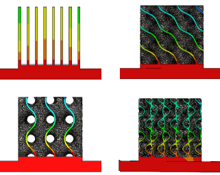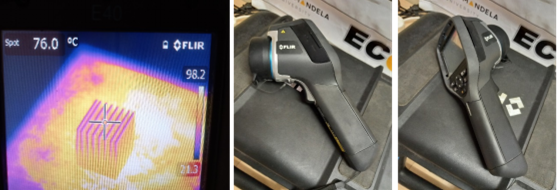This project was carried out with the invaluable collaboration of
 and
and 
please see a full listing of all contributors at the bottom of this post

the final display module of the Heat Sink Project
Project Outline
 An overlapping area of interest for the AEDG group is metal Additive Manufacturing, lattice design together with heat exchange optimization which resulted in this Honours Project.
An overlapping area of interest for the AEDG group is metal Additive Manufacturing, lattice design together with heat exchange optimization which resulted in this Honours Project.
With the modern-day computing power required nowadays for complex engineering designs and simulations, additional strain is placed on components such as the Central Processing Unit (CPU), resulting in heating issues which affect the performance of the computer. Heat sinks were introduced to counteract this heat gain, by allowing easier dissipation of the heat.
As devices become more compact, accompanying heat sinks also become smaller, yet still carrying the same load if not greater load as their predecessors which will require them to have a higher heat transfer efficiency.
Triply Periodic Minimal Surface (TPMS) lattices are unique to additive manufacturing as ordinary subtractive and formative manufacturing methods are not able to manufacture the complex design.
Although the idea of TPMS lattices mathematically originated in 1883, they were only investigated again by NASA in 1970, and they only began to gain popularity in 2018 as the use-cases for these lattices were beginning to become evident in parallel with AM evolution.

various lattice configurations: (l-r) diamond, gyroid & splitP lattice structures
The designing process begun using the cutting-edge nTopology implicit solver to create the various heat sink designs.
There are many lattice configuration options, but only 3 walled-varieties were considered in this project, namely Diamond, Gyroid and SplitP lattice types.
Apart from the lattice, the other variables in the design were the wall thickness and the cell size, which resulted in 15 TPMS heat sink designs as the test array. This limitations in numbers was mainly due to the fact that to metal 3D Print these devices is hugely expensive so an upper limit on number of variations was imposed to reduce these costs.
The benchmark was an additional common finned heat sink design. To eliminate further variables, all designs had the same outer dimensions of 30 x 30 x 30 mm, a bottom plate with a thickness of 2 mm and all were printed from 316 Stainless Steel.
The printing of the designs were kindly accommodated by long-term collaborators Rapid3D in Howick, KZN, who made use of their state-of-the-art EOS290 metal printing AM machine to create the heat sinks. The AM process used was Selective Laser Melting (SLM) which falls under the powder bed fusion process category.
The TPMS lattices were designed to be self-supporting which means that although the geometry is complex, there was no need for support structure which not only saved on additional cost, but was important in that for complex structures such as these, it is impossible to remove internal supports without severely compromising the lattice structures themselves.

(l-r) the printed Diamond, Gyroid, SplitP and Finned heat sinks
All testing and simulations were performed with a temperature source at a constant 100 °C throughout the entire process.

The objective was to establish at what temperature the top surface of the heat sink reaches an equilibrium or plateau temperature.
A thermal imaging camera, supplied courtesy of Custom Works, was used to capture thermal images of the heat sinks during the physical testing to confirm temperatures. These images were used to capture the temperatures at certain time intervals.
The recorded temperatures from the physical testing and the simulated data closely resembled each other with similar findings.
Therefore, it was possible to establish that the gyroid lattice heat sink design with 1 mm wall thickness and 15 mm cell size was the most efficient in terms of heat transfer.

thermal image and Flir E40 thermal camera
Contributors
Huge thanks & appreciation must go out to all these individuals for their completely selfless contribution to this, be it for information, advice, their time, their contacts, their services, or whatever contribution they made, no matter how big or small.
Custom Works (Arno Seyfert)
Rapid3D (Dave & Pauline Bullock)
NMU Mech Eng (Dr William Rall
NMU Materials Testing Lab (Dr Willem Pentz)
Stopforth Robotics & Research Lab (Prof Riaan Stopforth)
AEDG Team (Clive Hands, Jode Fourie, Brian Jack)